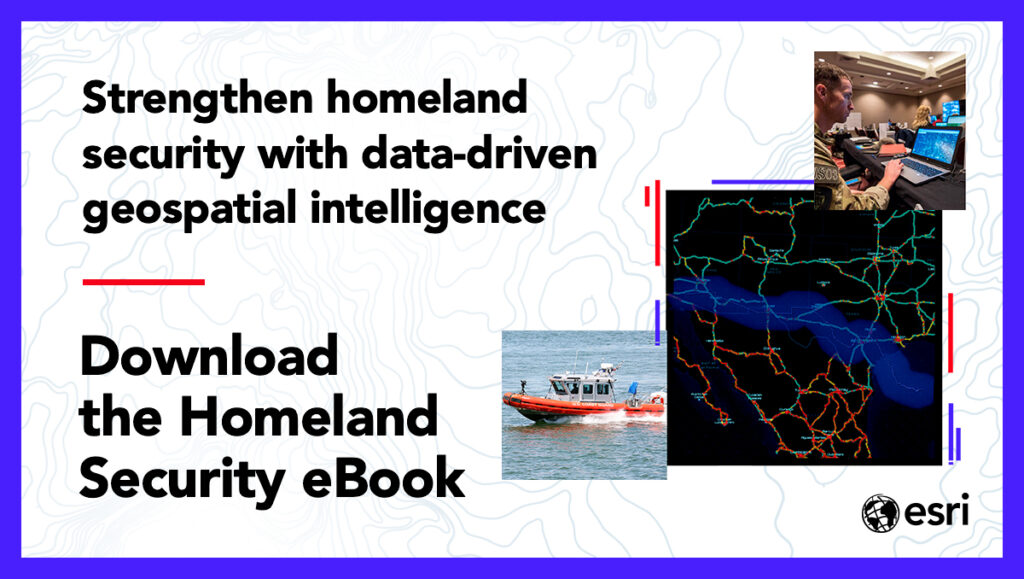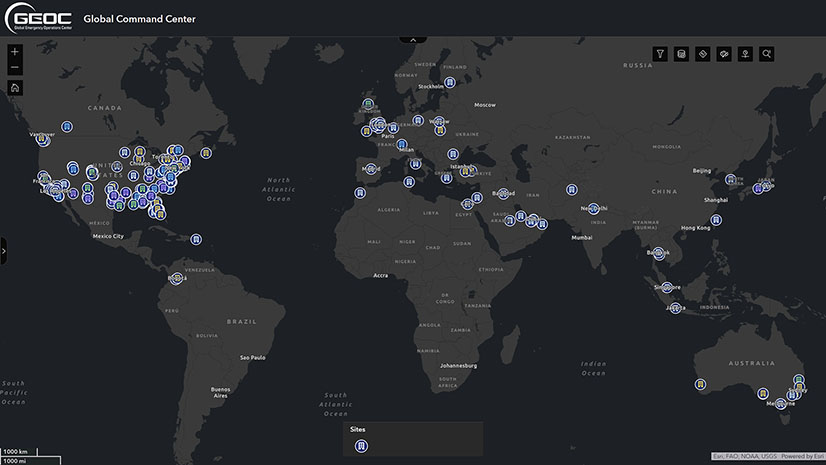
Imagine a technology that empowers users to make informed decisions, leading to effective responses in both routine operations and unplanned critical incidents. This technology enables real-time visualization and analysis, revealing patterns, relationships, and trends as they unfold. Geographic Information System (GIS) technology does exactly that.
Esri’s ArcGIS is a comprehensive suite of geospatial software tools designed to enhance homeland security capabilities and deepen understanding. As a leader in GIS technology, Esri offers solutions that transform your data, geospatial analysis, tradecraft, and enterprise GIS into actionable intelligence for homeland security organizations. ArcGIS provides advanced tools for a wide range of needs, including real-time monitoring, alerting, link analysis, geofencing, personnel tracking, risk assessment, emergency planning, and cross-agency collaboration. Its real-time data engines ensure you’re prepared for any security situation. ArcGIS also integrates seamlessly with indoor maps, sensors, physical security systems, and other technologies, optimizing your existing security infrastructure and emergency planning investments.
Whether you’re involved in public safety—covering areas such as drug enforcement, counterterrorism, crime suppression, border control, executive protection, maritime security, and critical infrastructure protection—or you have private sector security needs in finance, insurance, sports and entertainment, ports and airports, oil and gas, or retail, ArcGIS has the solutions you need.
What does it take to establish a geospatial concept of operations (CONOPS) for homeland security? The first step is to identify core use cases and workflows that align with industry analytical and operational best practices. By defining these foundational elements, you can develop a cohesive strategy that leverages geospatial technology to enhance situational awareness, improve decision-making, and streamline operations across your organization and the broader homeland security enterprise.
GIS and Real-Time Threat Management
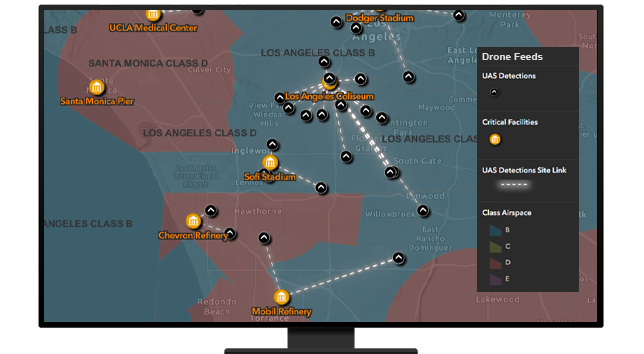
Combining GIS and real-time threat detection and monitoring can significantly enhance situational awareness, improve response times, and support rapid decisions during critical situations. GIS technology offers a comprehensive and efficient toolkit for real-time threat management by integrating the capabilities of real-time data engines (ArcGIS Velocity, ArcGIS GeoEvent Server) along with spatial analysis, sensor integration, data fusion, and visualization.
Here’s how GIS assists with real-time threat management:
- Data and Sensor Integration: GIS enables the integration of data from various sensors, monitoring devices, and commercial threat feeds like CCTV, alarms, AIS, 911, drones, weather feeds, and chemical detectors. By linking these sensors to a GIS platform, real-time data can be gathered and analyzed to swiftly detect and address potential threats. For instance, when a card reader detects unauthorized access, GIS can promptly generate an alert, providing the precise location of the infraction. to security personnel.
- Data Fusion: GIS allows for the integration and evaluation of data from multiple sources, including public databases, social media feeds, and internal organizational data. By integrating these diverse data sets, users gain a more comprehensive understanding of potential threats. For example, monitoring social media feeds for security-related keywords helps identify emerging threats at specific locations.
- Incident Mapping and Tracking: GIS lets analysts map and track incidents in real time and historically. By capturing the location, nature, and status of threats, GIS assists in coordinating response efforts, resource allocation, and providing accurate information to relevant stakeholders.
- Prioritized Monitoring: GIS enables prioritized monitoring through geofencing, creating virtual boundaries that trigger alerts based on predefined threat criteria. For example, if a GIS detects a critical event breaching a geofence around a sensitive facility, it triggers an immediate alert.
- Threat Escalation and Incident Triage: GIS allows for effective threat management through clear protocols for escalating and reporting alerts to ensure appropriate action. Incident triage evaluates and prioritizes security incidents based on severity and potential impact, enabling efficient tracking, response, and resolution.
- Cross-Agency Collaboration: GIS facilitates effective communication and collaboration among stakeholders in threat management. By sharing real-time threat information, situational updates, and response plans through GIS-based platforms, different teams and organizations can collaborate more efficiently and coordinate their efforts.
GIS and Intelligence Analysis
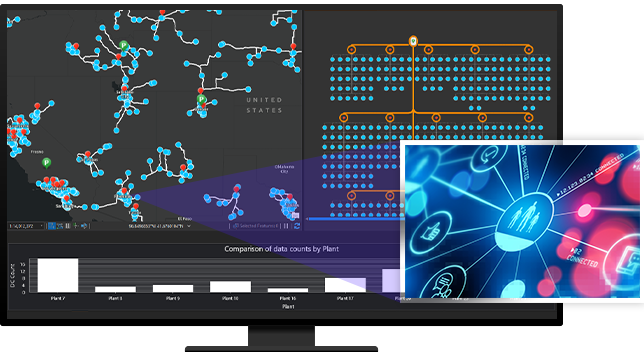
Intelligence and analysis refer to gathering, evaluating, and interpreting information to gain insights and make data-driven decisions. For security organizations, intelligence and analysis are crucial in understanding complex situations, identifying patterns, uncovering hidden relationships, forecasting trends, and supporting decision-making processes. GIS supports this effort by introducing a spatial framework for organizing, integrating, analyzing, and interrelating diverse data sources.
- Data Integration: GIS allows for integrating and storing various data types, including geographic, demographic, social, economic, threat, crime, and environmental data. This enables analysts to understand spatial relationships and patterns comprehensively.
- Visualization: GIS enables the visual representation of data through maps, charts, and graphs, helping analysts identify spatial patterns, outliers, and anomalies, which leads to deeper insights and more effective communication.
- Spatial Analysis: GIS provides powerful tools for examining data in its geographic context. Analysts can perform proximity analysis, spatial clustering, link analysis, and hot spot identification to uncover patterns, correlations, and trends not evident in tabular data alone.
- Geospatial Intelligence: GIS generates location-based intelligence by combining spatial analysis, visualization, and modeling with domain-specific knowledge. This provides a deeper understanding of spatial dimensions, enhancing security planning.
- Geospatial Modeling: GIS supports creating models to simulate scenarios, forecast outcomes, and evaluate impacts. Analysts can develop models with various data layers to assess risks, predict trends, and share tradecraft.
- Collaboration and Data Sharing: GIS enables collaboration and data sharing among analysts and stakeholders. Using a common geospatial platform, analysts can share data, analyses, and visualizations, promoting interdisciplinary collaboration and more comprehensive intelligence products.
GIS and Critical Event Management
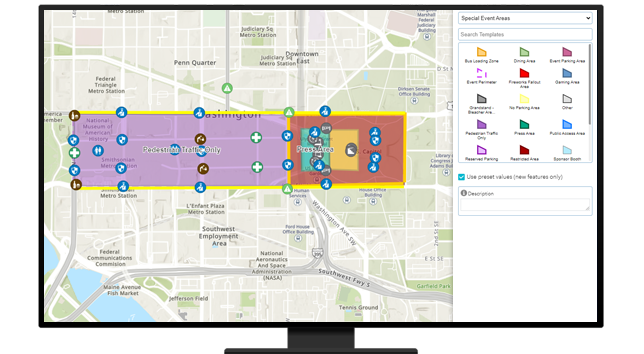
Critical event management (CEM) refers to preparing for, responding to, and recovering from critical events or incidents that can significantly impact organizations, communities, or the environment. These scenarios range from large-scale planned events to human-made critical incidents, natural disasters, or public health emergencies.
- Emergency Planning and Preparedness: GIS enables the development of emergency response plans, modeling scenarios, and simulating outcomes. It helps identify vulnerable areas, evacuation routes, and resource allocation strategies based on spatial analysis.
- Real-time Data Visualization: GIS allows for the integration of real-time data feeds like weather, sensors, and social media into maps and dashboards, enabling decision-makers to monitor events as they unfold and make informed decisions.
- Historical Analysis: GIS lets analysts facilitate historical threat analysis to provide insights into past security incidents and patterns. This helps identify vulnerabilities and recurring threats, enabling proactive risk mitigation.
- Situational Awareness: GIS creates situational awareness by providing a comprehensive view of an event’s location, affected areas, and relevant assets. Overlaying multiple data layers helps understand impacts and plan response strategies.
- Resource Management: GIS allows for tracking and managing resources during critical events, displaying the location, status, and availability of personnel and equipment for efficient allocation and deployment.
- Incident Response and Cross-Agency Coordination: GIS enables a common operational picture for efficient incident response and coordination. Real-time information sharing and tracking ensure a coordinated response among stakeholders.
- Damage Assessment and Recovery: GIS aids in damage assessment and recovery efforts by assessing damage extent, prioritizing recovery actions, and allocating resources effectively. It also helps communicate recovery progress through interactive maps and dashboards.
GIS and Executive Protection
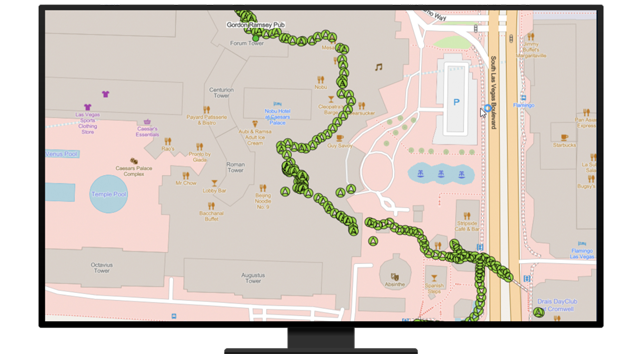
Executive protection refers to the security measures taken to ensure the safety of high-profile individuals, such as corporate executives, government officials, celebrities, or diplomats. GIS empowers executive protection teams with enhanced situational awareness, improved planning and navigation capabilities, risk assessment and mitigation strategies, efficient event management, and streamlined communication.
- Threat Assessment and Risk Analysis: GIS enables the gathering and analysis of data on threats like crime rates, political instability, and geographical hazards. By overlaying this with executive travel itineraries, security professionals can assess risks and implement appropriate measures.
- Route Planning and Navigation: GIS allows for the planning of safe routes for executive travel by considering traffic conditions, road safety, and crime hot spots. It also provides real-time navigation updates on road closures, accidents, or other incidents.
- Geofencing and Proximity Alerts: GIS enables the establishment of virtual boundaries around specific areas, triggering alerts when an executive enters or exits these zones, enhancing situational awareness and proactive security measures.
- Asset and Personnel Tracking: GIS lets analysts track the location of executive protection personnel and assets in real time, integrating GPS tracking for improved coordination and response times.
- Emergency Response and Crisis Management: GIS allows for the overlaying of critical data like emergency services, medical facilities, and evacuation routes to assist security teams in making rapid decisions during emergencies.
- Surveillance and Threat Detection: GIS enables integration with surveillance systems and sensors to monitor critical areas. By overlaying live camera feeds on a map, security personnel can visualize surroundings and respond to potential threats.
- Intelligence Analysis and Situational Awareness: GIS lets analysts integrate other intelligence sources to provide a comprehensive situational awareness platform, helping executive protection teams identify potential threats and emerging patterns.
GIS and Physical Security
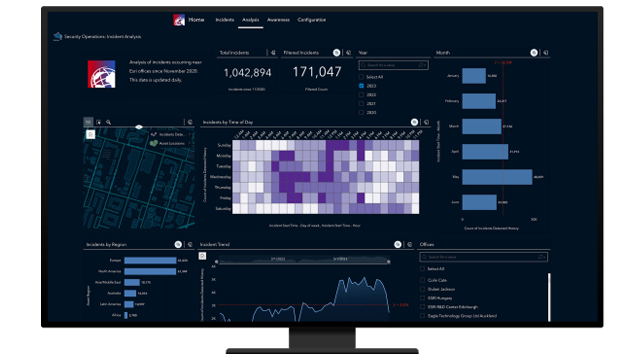
Geographic information systems provide a spatial framework for analyzing, visualizing, and managing physical security and environmental design data. It involves implementing strategies and measures to protect facilities, assets, and people, and promotes crime prevention and safety by designing and managing the built environment. GIS further assists in gathering and analyzing spatial data, which enables location-based decisions for physical barriers, surveillance, lighting, and access control. By leveraging these approaches, a secure environment can be created that deters crime, mitigates risks, and enhances safety for everyone involved.
- Site Selection and Evaluation: GIS aids in identifying and evaluating optimal locations for physical assets, buildings, and facilities. By analyzing data such as crime rates, demographics, proximity to infrastructure, environmental design, and terrain features, GIS helps determine the most suitable and secure sites.
- Risk Assessment: GIS enables the integration and analysis of data layers like crime data, environmental hazards, building design, and transportation networks. By conducting spatial analysis, GIS identifies high-risk and vulnerable areas, guiding resource allocation and security measures.
- Perimeter Security: GIS assists in designing and optimizing physical security perimeters. By comparing threats and security gaps with data on land use, topography, and existing infrastructure, GIS determines the optimal placement of barriers, fences, gates, and access control points, and can simulate scenarios to evaluate weaknesses.
- Video Surveillance and Sensor Placement: GIS supports the strategic placement of video surveillance cameras, motion sensors, and other security sensors. By combining spatial data with information about line of sight, camera range, and potential obstacles, GIS optimizes device positioning to maximize coverage and situational awareness.
- Emergency Response Planning: GIS is crucial for emergency response planning and critical event management. By integrating data on infrastructure, evacuation routes, emergency services, and population density, GIS helps identify vulnerabilities and plan effective response strategies, including evacuation zones and emergency shelter locations.
- Incident Mapping and Analysis: GIS maps and analyzes security incidents like thefts, break-ins, or breaches. By visually representing incidents on a geographic map over time, GIS allows for identifying patterns, hot spots, and trends, aiding in efficient resource allocation and proactive measures.
- Access Control and Asset Management: GIS strengthens access control systems by integrating location-based data with information on restricted areas, security guards’ positions, alarms, and sensors. GIS provides a targeted perspective of sensitive areas and tracks asset movement within facilities or across locations.
Indoor Maps for Safety and Security
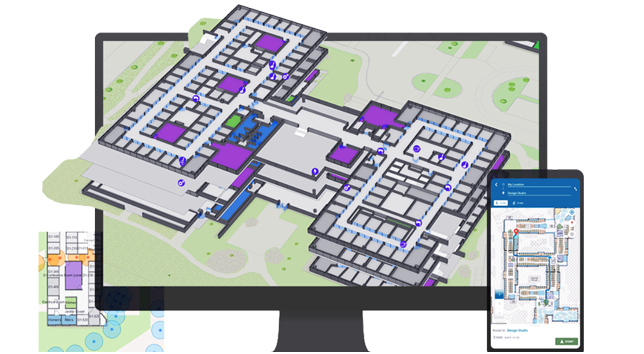
GIS and indoor mapping can enhance security in various environments, including buildings, campuses, airports, malls, and other indoor spaces. By combining these technologies, security personnel can exploit floor-aware visualization and respond more effectively to security incidents.
- Facility Mapping and Navigation: GIS enables the creation of detailed indoor maps, helping security personnel navigate and understand indoor layouts. This indoor awareness is crucial for rapid response and evacuation during emergencies or security incidents.
- Asset and Personnel Tracking: GIS integrates with real-time tracking systems to monitor the location of assets and personnel within a building. Floor-aware visualization enhances emergency response and personnel safety.
- Access Control and Surveillance: GIS lets analysts link access control systems and surveillance cameras to specific locations on an indoor floor plan. This provides a visual representation of security events and quickly identifies security breach locations.
- Incident Visualization: GIS-based indoor maps enable real-time incident visualization, displaying emergency exits, escape routes, and areas to avoid. This aids in coordinating responses and ensures teams are well-informed about indoor layouts.
- Emergency Response Planning: GIS allows for the creation and optimization of emergency response plans using indoor maps. This includes visualizing emergency exits, assembly points, and safe zones, and simulating scenarios to identify potential weaknesses.
- Integration with IoT Devices: GIS enables the connection of Internet of Things (IoT) devices, such as motion sensors and card readers, to the system. When an event is triggered, the system shows the device’s location on the indoor map, aiding in identifying the alert source.
- Training and Drills: GIS-based indoor maps facilitate training and emergency drills, providing realistic environment representations. This helps staff practice responding effectively to various scenarios.
GIS and Business Resilience
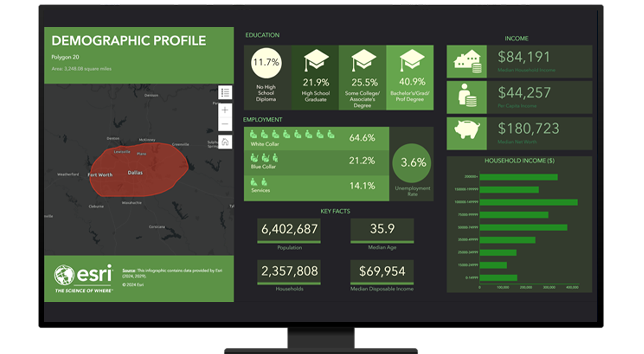
GIS contributes to the long-term resilience of organizations. It equips decision-makers with the necessary insights and tools to navigate uncertainties, address risks, and respond swiftly to disruptions. This resilience ensures companies adapt, recover, and thrive in an unpredictable business and security landscape.
- Risk Assessment and Planning: GIS enables organizations to examine and depict diverse risk elements like natural disasters, supply chain vulnerabilities, and market conditions. By incorporating spatial data, GIS pinpoints high-risk areas and formulates strategies to mitigate potential dangers, facilitating effective continuity planning.
- Crisis Management: GIS allows for real-time data visualization and analysis to support emergency response efforts. By integrating data from weather, traffic, and infrastructure sources, GIS helps identify affected areas, coordinate resources, and make timely decisions for effective crisis management.
- Supply Chain Security: GIS lets analysts visualize the entire supply chain, mapping suppliers, warehouses, transportation routes, and distribution centers. By analyzing spatial relationships with threat and crime data, GIS identifies potential security gaps and weak points.
- Site Selection: GIS assists in site selection for new facilities or expansion by analyzing spatial data, including demographics, market trends, and infrastructure availability. This helps identify optimal locations that minimize risks and maximize growth opportunities.
- Asset Management: GIS enables efficient management and maintenance of physical assets by collecting location-based data on equipment, infrastructure, and facilities. This allows for monitoring maintenance tasks, tracking asset performance, and planning replacements or repairs.
- Stakeholder Communication: GIS provides a platform for visualizing and communicating complex data clearly. It allows organizations to share spatial information with stakeholders through maps, interactive dashboards, and reports, fostering effective communication and collaboration.
GIS and Climate Security
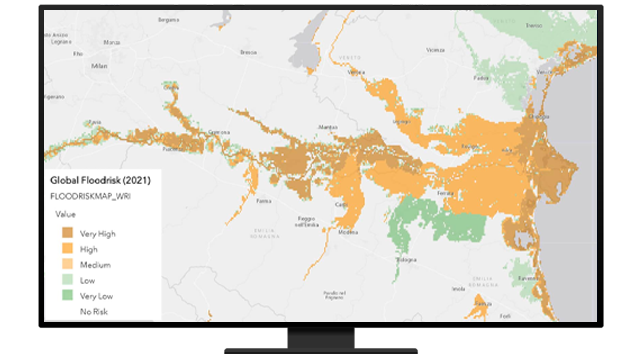
Climate security and GIS have multiple intersections that can address the challenging circumstances of climate change and its effects on safety and security.
- Risk and Vulnerability Mapping: GIS enables the assessment of climate risks and mapping of vulnerabilities, integrating diverse geospatial data to identify and prioritize measures for mitigating climate threats by highlighting vulnerable areas and critical assets.
- Conflict and Migration Analysis: GIS allows for the analysis of climate-induced conflicts and migration patterns, helping security professionals and policymakers develop strategies to prevent and manage conflicts and humanitarian crises caused by climate change.
- Early Warning Systems: GIS lets analysts develop early warning systems for climate hazards by integrating real-time data, which enables timely detection and monitoring of events like floods and wildfires, thus enhancing emergency response and climate security.
- Natural Resource Management: GIS allows for sustainable natural resource management by mapping ecosystems, land use, and biodiversity, aiding in the assessment and planning of renewable energy resources to mitigate climate change.
- Infrastructure Planning: GIS enables the planning of climate-resilient infrastructure by analyzing data on infrastructure networks and their exposure to climate risks, supporting decisions for adaptations like flood-proofing and resilient building design.
- Operationalize Basemaps: GIS lets analysts create base-maps as digital twins of an organization’s area of responsibility, integrating climate risks into dashboards for real-time monitoring and proactive communication of potential disruptions.
Why Esri – GIS Transforms Your Homeland Security Framework
One Platform—Many Missions
GIS is a unified platform that can be applied to multiple missions or tasks. It provides a configurable framework for managing and operationalizing information, enabling users from different security sectors to leverage its capabilities for their specific missions while removing the need for multiple-point solutions.
Interoperability
Esri uses open standards and integrates easily with different security systems and technologies. This provides access to additional sources of information while helping organizations maximize their existing security infrastructure and technology investments, preventing organizations from getting locked into proprietary solutions.
Cross-Agency Collaboration
Esri technology and its reliance on open standards support numerous collaborative features that enhance communication and coordination within agencies and across organizations. Chat, video conferencing, and document sharing can be integrated into GIS, further leveraging the value of collective impact across domains.
Virtualized Operations
Command center managers must embrace virtual operations to meet the demands of modern security organizations. Esri’s Web GIS platform provides organizations with the necessary tools to coordinate and manage operations remotely, especially during emergencies and public health crises. Virtual operations enhance flexibility and scalability, reduce cost, extend geographic reach and communication, and improve business continuity. With Web GIS, organizations can seamlessly adapt to evolving circumstances, optimize resource utilization, and achieve operational success, from any physical location, not just the command center.
The Esri Ecosystem
The Esri ecosystem is a global network of GIS users and organizations interconnected through software, tools, data, and mission. It facilitates smooth data sharing, encourages collaboration, and enhances skills within the GIS and security communities. This network allows users to access numerous opportunities for data sharing, collaboration, and collective problem-solving. This is especially advantageous for the homeland security enterprise, as it enables local, state, federal, and private security organizations to significantly reduce costs by collaborating and sharing their existing GIS investments. This ecosystem includes approximately 350,000 organizations and 10 million individual users.
Learn more
Explore how GIS can be applied across key areas of the homeland security enterprise in our multipart blog series, Exploring the Role of GIS in Homeland Security. You can also visit our solutions page or download our ebook.
